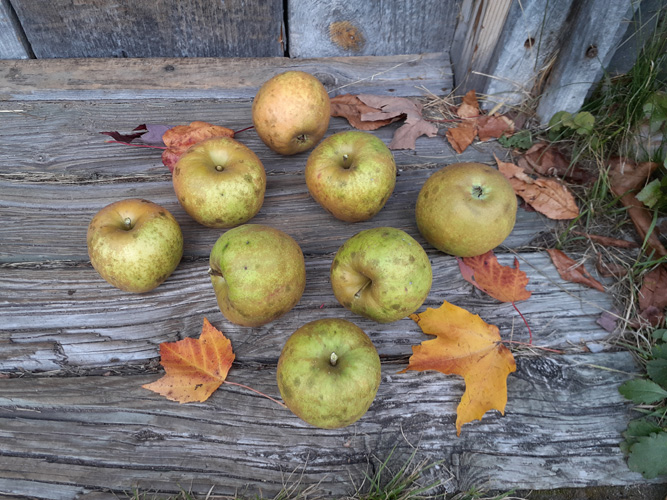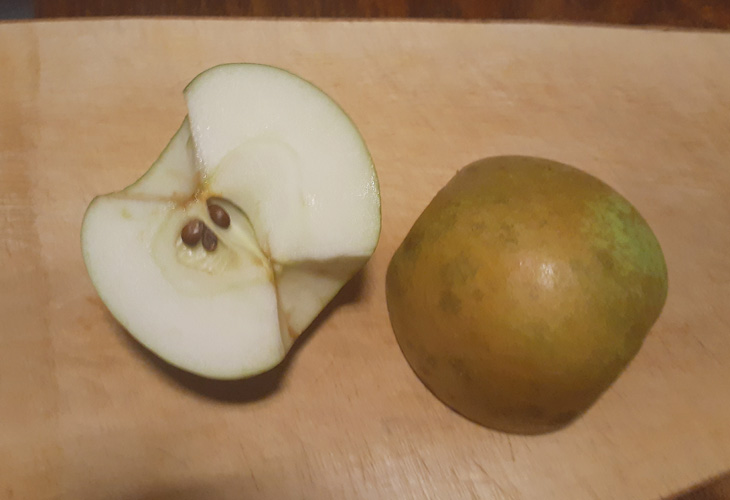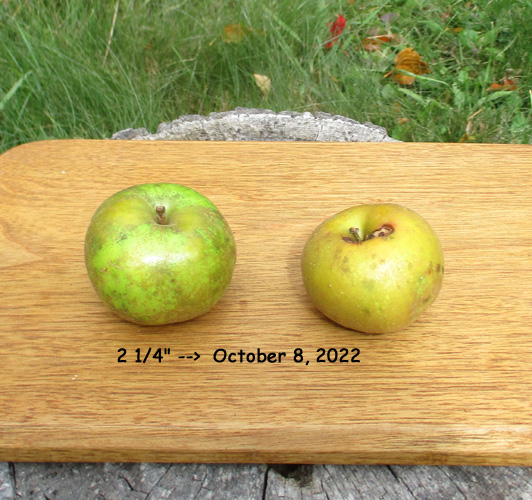|
| |||
|
Apples
Blueberries |
The ManyTracks Orchard Gray Pearmain Apple
Grafted 2013 -- (1) branch of wild seedling
Splitter |
Akero |
Hoholik |
|
2013 grafted with scion from Fedco, Maine. One on a south branch of wild apple 'Splitter' (east of shop), and a second on a low branch of wild seedling whose main graft is Honeycrisp by the outhouse. It took almost ten years to fruit but it's a nice mild sweet apple with enough hint of pear texture and flavor to see why it has Pearmain in its name. 2025 - #1 (Splitter) - Took off several branches bringing it more in with rest of tree. No fruit. 2024 - #1 (Splitter) - Pruned a lot to get it more in line with Splitter's growth. Picked Oct.10 after two mid-20's nights, and a stretch of rain forecast. Six apples - fair amount of russet, 1 brighter green, 1 some yellowish, others dull green. All had been bagged and were in good shape.
2022 - #1 (Splitter) continues vigorous, really too vigorous for moderate growing Splitter, with healthy growth. Did a lot of pruning to bring it in better balance. Steve cut down the dying elm that was directly south of the tree, greatly lengthening the amount of full sun it receives, from 2 1/2 hrs to 5-6 hrs. This should make a big difference in future years. But even this year, to my surprise and hopeful delight, having never tasted a Gray Pearmain, I saw it had a bloom the end of May. Being the first there wasn't a lot of hope for a fruit but there was some. The main Splitter tree was fairly full of blooms. Later I discovered not one, but THREE Gray Pearmain fruits. Wow. September 21 was the discovery that the birds had significantly pecked one of the Hoholik apples on the tree and had started in on the Gray Pearmains. Grrrr... I grabbed the tulle carrot seed bags I had made several years ago and put them on all the "special" apples. That worked, but with the damage and a stretch of rainy weather I'm afraid the GP's didn't come out looking too good. But at least they were there. October 6 -- The First Gray Pearmains With several low 20's freezes forecast and a spell of rain to follow I decided to pick just in case the temps went lower and damaged these long awaited fruits (the graft is from 2013). I had considered if I should simply cut off this grafted branch since it had taken so long to fruit, but considering the lack of sun access it's likely a surprise that the tree manages to fruit at all (the main tree usually has a moderate crop). But this year it saved itself by setting those three apples, the first of which the birds got to before I did, doing significant damage so I got only a small bit of the obviously not ripe apple, but it was nicely sweet and with great potential. The other two I picked this day. They certainly aren't model specimens with bird and bug damage and surface blemishes but here they were, in person (so to speak), not just a photo online.
One was obviously green, the other with more yellow was maybe ripe? Since the yellowish one was damaged I cut that one up right away. It was firm, not very juicy, rather like a Black Oxford. It had a nice sweet flavor even though it turned out it wasn’t fully ripe (seeds partially brown). But it was enough to make me anticipate some really good eating if they could ripen fully. I’m a bit concerned about that because this is rather late (October) for fruit to ripen here. The obviously green one is in the root cellar awaiting, hopefully, further ripening. But this is the first fruit for this graft and the tree it is on doesn’t get ideal sun. It will likely change as it matures. November 12 - The greenish fruit was starting to feel a bit rubbery so I decided not to wait any longer though it was still the same green color. To my surprise the seeds were brown. There was some insect damage but the texture inside was fine, certainly eatable, and the flavor nice - gently sweet with no tartness or hint of under-ripeness. I'm feeling much better and hopeful about this variety and look forward to more fruit in years to come. #2 (outhouseHC) - Continues with very small growth but doing OK. This tree also gets little good sun. 2021 - #1 (Splitter) vigorous, healthy growth. #2 (outhouseHC) OK. 2019 - #1 Splitter more vigorous (older tree), healthy. #2 slow growing but doing OK.
2018
- #1 - Good 5-12"
growth side branches & several longer shoots. Looks good.
2017 - #1 - Good growth, healthy,
light blight/insect presence. 2015 - #1 - good growth. #2 - growing but still thin, looks rough a few inches of stem around graft but guess is OK. 2014 - (#1) - Cut back 1/3 long shoot. Turned out all last years shoot winterkilled. Thankfully some shoots growing on prev year’s growth. (#2) - growing fine, but rather thin. 2013 - Scion from Fedco. (#1) - grafted on south branch of wild "splitter" tree east of shop. Finally popped 6/27! Grew fine. (#2) - grafted on east branch of "Honeycrisp2" apple by outhouse. 6/16 a bit of green showing at both buds. Hurray!
Online Notes: Fall-Winter.
Delicious fresh eating with distinct pear flavor, firm white juicy, mildly tart
flesh. Steadily gaining a devoted following. Medium-sized slightly ribbed and
muffin-shaped fruit has a soft opaque greenish-yellow skin with a rosy pink
blush, a russet veil, and a greyish bloom. Produces excellent juice. Pick late
and eat them in the fall and all winter. Ttres growing in Fairfield, Maine.
Annually bearing easy-to-grow medium-sized spreading tree. Probably Skowhegan,
ME, before 1870. Z4-6. |
|||


